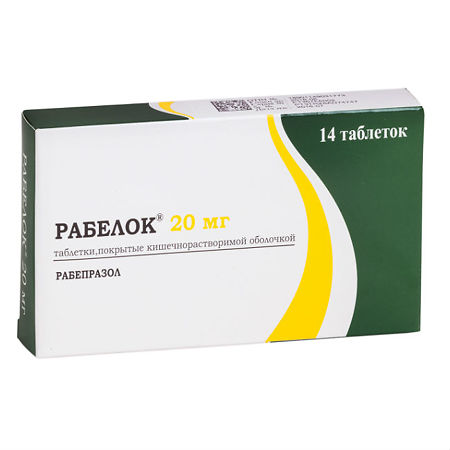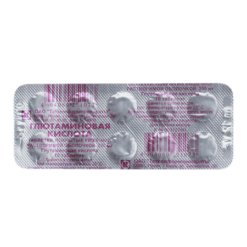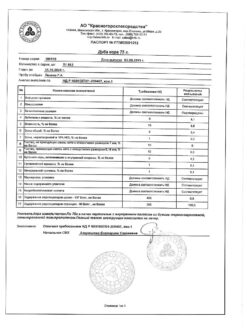No products in the cart.
Rabelock, 20 mg 14 pcs.
€14.41 €12.01
EAN: 8901149031776
SKU: 262784
Categories: Medicine, Stomach, intestines, liver, Ulcer and gastritis
Description
An antiulcer agent from the group of H+/K+ATPase proton pump inhibitors), metabolized in the parietal cells of the stomach to active sulfonamide derivatives, which inactivate the sulfhydryl groups of H+/K+-ATPase.
Blocks the final stage of hydrochloric acid secretion, reducing basal and stimulated secretion, regardless of the nature of the irritant. It has high lipophilicity, easily penetrates into the parietal cells of the stomach and concentrates in them, having cytoprotective effect and increasing the secretion of hydrocarbonate.
The antisecretory effect after oral administration of 20 mg occurs within 1 hour and reaches a maximum after 2-4 hours; inhibition of basal and food-stimulated acid secretion 23 hours after the first dose is 62 and 82% respectively, duration of action is 48 hours. After the end of the intake, secretory activity normalizes within 2-3 days.
In the first 2-8 weeks of therapy, gastrin concentration in serum increases and returns to baseline levels within 1-2 weeks after withdrawal. It does not affect the central nervous system (CNS), cardiovascular and respiratory systems. No sustained changes in the morphological structure of enterochromaffin-like cells, in the severity of gastritis, in the frequency of atrophic gastritis, intestinal metaplasia or the spread of Helicobacter pylori infection were found during rabeprazole administration.
The effect on plasma gastrin concentration. At the beginning of therapy with rabeprazole, plasma gastrin concentration increases, which is a reflection of the inhibitory effect on hydrochloric acid secretion. Gastrin concentration usually returns to initial level within 1-2 weeks after discontinuation of treatment.
Indications
Indications
Peptic ulcer of the stomach and duodenum in the acute phase;
peptic ulcer of the stomach and duodenum associated with Helicobacter pylori (in combination with antibiotics); gastroesophageal reflux.
Pharmacological effect
Pharmacological effect
An antiulcer agent from the group of proton pump inhibitors H+/K+ATPase), is metabolized in the parietal cells of the stomach to active sulfonamide derivatives that inactivate the sulfhydryl groups of H+/K+ ATPase.
Blocks the final stage of hydrochloric acid secretion, reducing the content of basal and stimulated secretion, regardless of the nature of the stimulus. It is highly lipophilic, easily penetrates into the parietal cells of the stomach and concentrates in them, exerting a cytoprotective effect and increasing the secretion of bicarbonate.
The antisecretory effect after oral administration of 20 mg occurs within 1 hour and reaches a maximum after 2-4 hours; inhibition of basal and food-stimulated acid secretion 23 hours after taking the first dose is 62 and 82%, respectively, the duration of action is 48 hours. After finishing the dose, secretory activity normalizes within 2-3 days.
In the first 2-8 weeks of therapy, the concentration of gastrin in the blood serum increases and returns to initial levels within 1-2 weeks after discontinuation. Does not affect the central nervous system (CNS), cardiovascular and respiratory systems. While taking rabeprazole, consistent changes in the morphological structure of enterochromaffin-like cells, the severity of gastritis, the incidence of atrophic gastritis, intestinal metaplasia, or the spread of Helicobacter pylori infection were not detected.
Effect on gastrin concentration in blood plasma. At the beginning of rabeprazole therapy, the concentration of gastrin in the blood plasma increases, which is a reflection of the inhibitory effect on the secretion of hydrochloric acid. Gastrin concentrations return to baseline levels usually within 1-2 weeks after cessation of treatment.
Special instructions
Special instructions
Before starting therapy, it is necessary to exclude malignant neoplasms of the stomach, because the use of rabeprazole may mask symptoms and delay correct diagnosis.
No dosage adjustment is required in patients with hepatic or renal impairment; however, rabeprazole should be used with caution in patients with severe hepatic impairment.
When used simultaneously with rabeprazole, the doses of ketoconazole and digoxin should be adjusted.
Experimental studies have not established the carcinogenic effect of rabeprazole, however, when studying mutagenicity, ambiguous results were obtained. Tests on lymphoma cells in mice were positive, while the in vivo micronucleus test and the in vivo and in vitro DNA repair test were negative.
Active ingredient
Active ingredient
Rabeprazole
Composition
Composition
1 tab. contains rabeprazole sodium – 20 mg
Excipients:
mannitol – 89 mg,
magnesium oxide – 80 mg,
hypromellose – 5 mg,
microcrystalline cellulose – 20 mg,
starch – 20 mg,
carmellose – 20 mg,
talc – 3 mg,
magnesium stearate – 6 mg,
colloidal silicon dioxide – 3 mg.
Shell composition:
hypromellose – 9.5 mg, propylene glycol – 1.5 mg.
Enteric coating composition:
methacrylic copolymer acids and ethyl acrylate (type C) (1:1) – 13.95 mg, polysorbate 80 – 0.209 mg, dibutyl phthalate – 2.090 mg, sodium hydroxide – 0.119 mg, yellow iron oxide dye – 0.783 mg, talc – 5.63 mg, titanium dioxide – 1.210 mg.
Contraindications
Contraindications
Pregnancy, lactation (breastfeeding), hypersensitivity to rabeprazole sodium or substituted benzimidazoles.
Side Effects
Side Effects
From the digestive system: diarrhea, nausea, abdominal pain, vomiting, flatulence, constipation; rarely – dry mouth, dyspepsia, belching; in isolated cases – anorexia, gastritis, stomatitis, increased activity of liver transaminases.
From the central nervous system and peripheral nervous system: headache, asthenia, dizziness, insomnia; rarely – nervousness, drowsiness; in isolated cases – depression, visual and taste disturbances.
From the respiratory system: possible – rhinitis, pharyngitis, cough; rarely – sinusitis, bronchitis.
Allergic reactions: rarely – skin rash; in isolated cases – itching.
Other: back pain, flu-like syndrome; rarely – myalgia, chest pain, chills, calf muscle cramps, urinary tract infection, arthralgia, fever; in isolated cases – increased body weight, increased sweating, leukocytosis.
Interaction
Interaction
When used simultaneously with digoxin, an increase (from small to moderate) in the concentration of digoxin in the blood plasma is possible.
When used simultaneously with ketoconazole, its bioavailability decreases.
Overdose
Overdose
Information about overdose is minimal. It has been reported to take rabeprazole at a dose of 60 mg 2 times a day and 160 mg once. Side effects were minimal and did not require medical intervention.
Treatment. A specific antidote is unknown. Rabeprazole binds well to plasma proteins and is therefore poorly excreted during dialysis.
In case of overdose, symptomatic treatment is necessary.
Manufacturer
Manufacturer
Cadila Pharmaceuticals Ltd, India
Additional information
| Manufacturer | India |
|---|---|
| Medication form | enteric-soluble film-coated tablets |
Related products
Buy Rabelock, 20 mg 14 pcs. with delivery to USA, UK, Europe and over 120 other countries.











